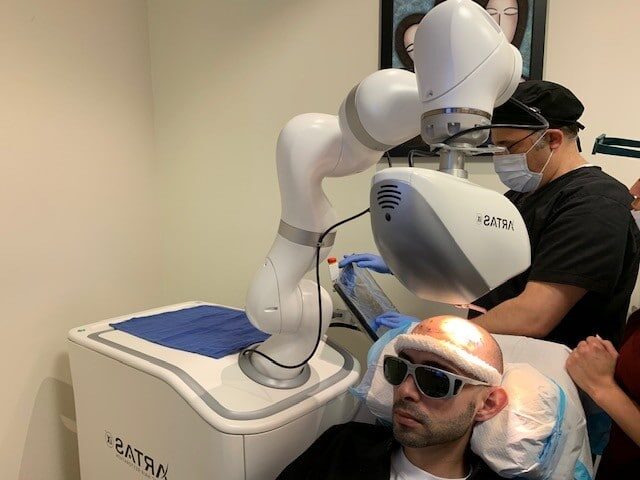It may sound like science fiction, but artificial intelligence is changing how we practice aesthetic medicine. This is especially true when it comes to hair restoration. Robotic hair restoration that uses artificial intelligence provides patients with better, more cost-effective outcomes with less recovery time.
Androgenetic alopecia, better known as common
male pattern baldness, accounts for most hair loss in men. According to the
American Hair Loss Association, more than half of American men will have experienced some type of noticeable hair loss by the age of 35. Once they reach 50, approximately 85% of men will have significantly thinning hair.
While non-surgical and regenerative treatments such as
Platelet Rich Plasma (PRP) and
stem cell injections can be effective for hair restoration, hair transplantation is the next step to restore significant hair loss.
The ARTAS iX robotic hair transplant system combines robotic and artificial intelligence to create the world’s first intelligent hair transplant platform. This game-changing, FDA-approved procedure extracts and implants hair follicles more precisely and efficiently than other methods, which provides a better patient experience.
Dr. David Melamed, is a recognized innovator in hair restoration in Los Angeles, Southern California, offering the innovative ARTAS iX treatment to his patients. West LA Hair Restoration is the only location in Los Angeles with the latest ARTAS technology, the iX device, on-site. While earlier generations of the ARTAS robot focused on hair follicle extraction, this next-generation model also does implantation.
A History of Hair Transplantation
Hair transplantation techniques have come a long way over just a few decades. What used to involve invasive cutting has evolved into a
1-Day Hair Restoration, a minimally-invasive procedure that delivers natural-looking results.
Hair Plugs
The first hair plug procedures were done in the 1950s. This concept required circular skin grafts to be removed from the scalp, harvested, and then transplanted. Even though the results often looked unnatural, its popularity grew.
Follicular Unit Transplantation (FUT)
During the 1980s and into the 2000s, follicular unit transplantation (FUT) became the new go-to hair transplant procedure. In the FUT technique, a strip of skin is taken from the back of the head. Groups of hair follicles are then separated from the harvested strip and transplanted into pre-established micro-puncture sites. The transplanted follicles follow a specific pattern that better matches the patient’s hairline.
While the result had a more natural look than hair plugs, it resulted in linear scarring along the patient’s scalp. Patients often wore their hair longer to cover the scarring.
Follicular Unit Extraction (FUE) and Robotics
Today,
follicular unit extraction (FUE) is considered the best method for successful hair transplantation. This technique removes individual follicles of one to four hairs using local anesthesia and micro-punches. Additional micro-puncture sites are then created to transplant the grafts where they are needed. Since FUE uses smaller incisions to remove the follicle, stitches are not required.
The separation of the follicular units from the surrounding donor tissue is a repetitive and labor-intense process that requires great precision. The punch must be centered perfectly over the hair follicle, and the instrument aligned precisely with the follicles to prevent damage. This step is then repeated hundreds and even thousands of times in a typical manual FUE hair restoration procedure. This leaves the patient at risk for human error.
Robotics are now changing hair transplantation for the better. The ARTAS iX robot uses the FUE technique in tandem with artificial intelligence to deliver outstanding results in a fraction of the time.
How the ARTAS iX Robot Works
The ARTAS iX Robot is the first and only physician-assisted system designed to harvest hair follicles directly from the scalp. Thanks to its advanced technology, it can assist surgeons through what is the most significant, but also the most tedious stage of a hair transplant procedure — hair follicle removal. The ARTAS iX robot automates the majority of an FUE hair transplant procedure from graft harvesting to recipient site making, and with the new ARTAS iX, implantation.
The procedure begins with creating a 3D model of the patient’s head and current hairline. Using this information, we will customize a personalized hairline design that fits your features. Next, Dr. Melamed uses the ARTAS iX to plan the procedure and input the right diagnosis. This includes punch size selection and the correct depth, angle, and direction for implantation.
Dr. Melamed works side-by-side with the ARTAS iX to select the healthiest hair follicles from the donor area. Once these follicles are selected, they are removed robotically using a high-definition vision system, robotic arm, and artificial intelligence algorithms. The robot uses less tension, which helps protect the grafts from trauma.
Thanks to the ARTAS iX’s exact precision and speed, the natural look of the donor area is preserved. This method also prevents damage to the surrounding follicles and the need to remove portions of the scalp, which leads to a linear scar.
Once the follicles are harvested, the ARTAS iX uses its AI to place and simultaneously implant the follicles into the recipient site. This reduces bleeding, which is common when the recipient sites are remade. This method also eliminates other issues, such as making more sites than available grafts or placing two grafts in the same site. This minimally invasive procedure not only protects your existing healthy hair follicles but maintains a natural appearance throughout the hair.
The ARTAS iX is exceptionally accurate and significantly reduces human error. It is also efficient, performing up to 1,000 hair follicle grafts per hour. When it’s over, the patient has received a personalized hairline design in less time than other treatments and with significantly less risk for scarring.
The Benefits of the ARTAS iX
FUE using the ARTAS iX provides many patient benefits that ultimately lead to improved long-term results.
Less Discomfort
This virtually painless procedure eliminates the need for a scalpel, sutures, or stitches. That means there is no linear scarring on the scalp as with traditional manual hair transplant procedures. Any scarring that does happen is almost invisible.
While the process is generally painless, a local anesthetic will be used in the donor and recipient areas to ensure no patient discomfort.
Faster Return to Daily Activities
The recovery time is much faster since the ARTAS iX robotic hair restoration process is minimally invasive. The areas where follicles were harvested typically heal in a few days.
After the procedure, patients may experience some minor swelling or redness, which usually goes away after a day or two. Since no sutures are needed, patients can often resume their normal daily activities almost immediately. Patients can typically wash their hair gently the next day and resume their normal showering in less than a week.
No Over-Harvesting
The ARTAS iX uses its vision image guidance and the established treatment algorithm to remove precisely the number of grafts needed. This eliminates the potential of over-harvesting or excising hair follicles that ultimately go to waste.
Improved Results
The ARTAS iX system provides results that not only look natural but are long-lasting. Patients often start seeing noticeable hair growth within 3-6 months of the procedure. Substantial growth can continue for up to a year. This new hair will blend seamlessly with a patient’s existing hair.
The ARTAS iX procedure implants the chosen healthy follicles to the parts of the patient’s scalp most affected by hair loss to achieve the best results. Once implanted, these hair follicles develop their own blood supply and start to grow. In just a few months, new hair will start to grow as well.
This new hair will continue to grow over the next year. Hair will look thicker, bald areas will fill, and your own hair will grow back permanently. One benefit to robotic FUE is the ability to protect your existing, healthy hair follicles to preserve a more natural appearance.
More Precise in Less Time with Fewer Risks
ARTAS iX uses artificial intelligence to select the optimal hair follicles from the donor area. It then precisely places the transplanted hair in strategic areas to provide the most natural-looking results.
The ARTAS iX procedure is faster than traditional hair restoration techniques and eliminates the potential for human error with traditional FUE procedures. When humans get tired, robots can keep going. A traditional FUE procedure is often done over the course of several days in 2-4 hour sessions. In comparison, the ARTAS iX can complete the same procedure in one day, lasting just a few hours.
Cost-Effective
It’s hard to argue with the results. The ARTAS iX robot has a
96% “worth it” rating on Real Self.
Find Out If the ARTAS iX Procedure is Right for You
If you have a receding hairline, balding areas, or thinning hair, you owe it to yourself to learn more about the world’s most advanced robotic hair restoration system located conveniently in Southern California —ARTAS iX.
West LA Hair Restoration offers the latest hair restoration systems, including the ARTAS iX robotic assistant, to deliver natural and lasting results.
Dr. Melamed and his team can help you feel and look your best. Visit our website to learn more about
1-Day Hair Restoration and
book your consultation with Dr. Melamed at West LA Hair Restoration in Los Angeles, California.


